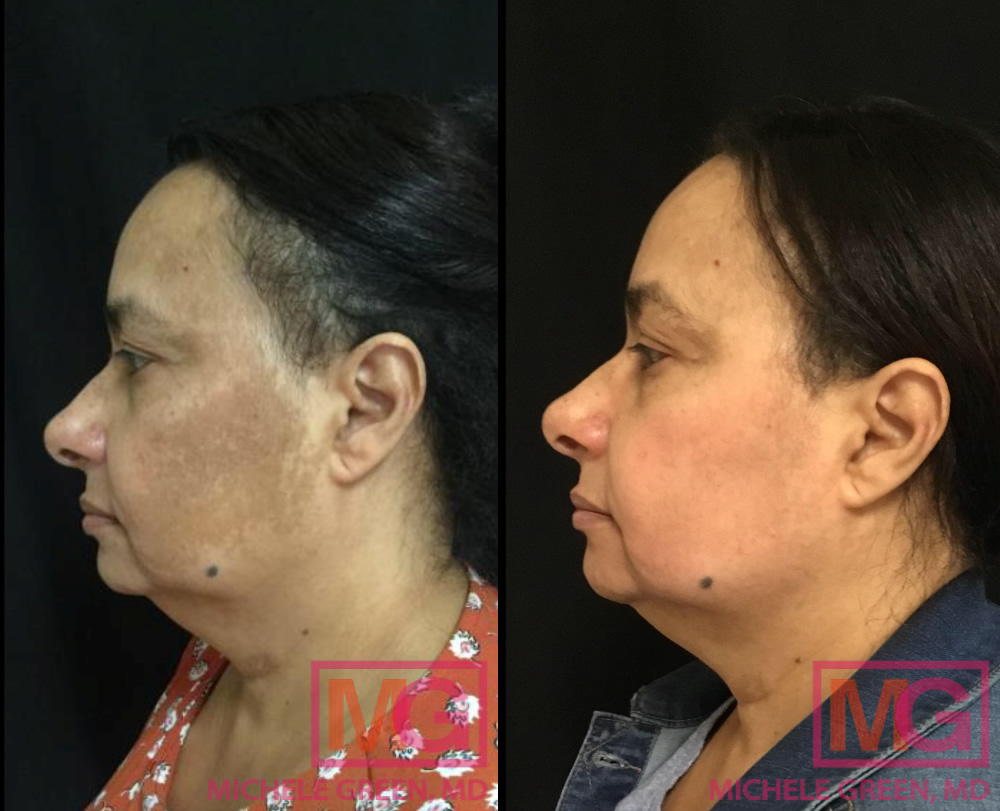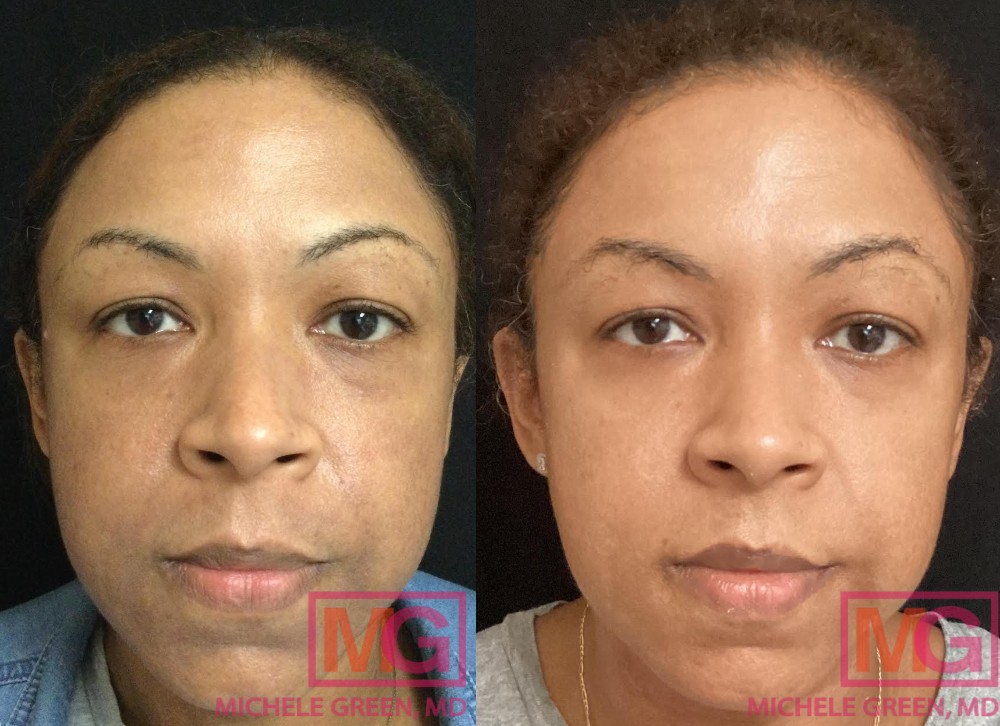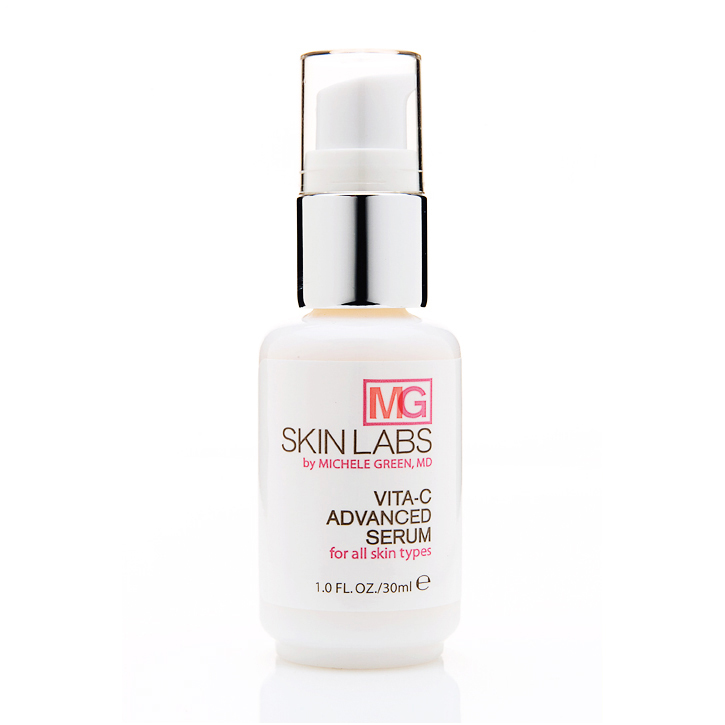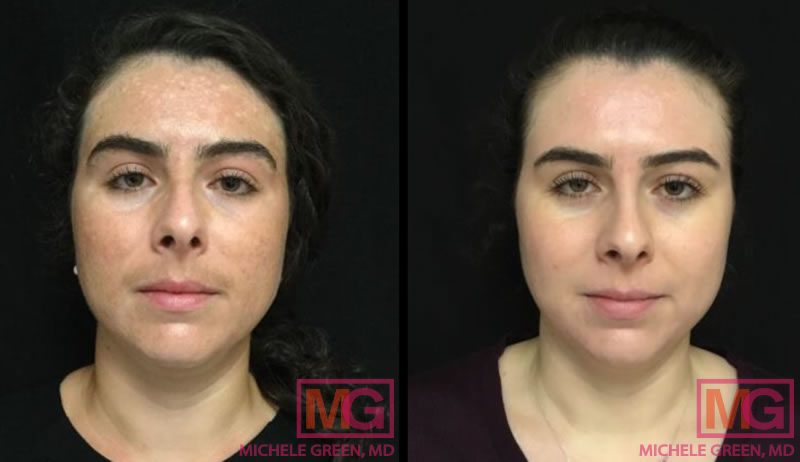What Is a Melasma Mustache
Melasma is a common skin condition characterized by brown, dark, or grey patches of skin that appear darker than the surrounding skin. Melasma on the upper lip is called a melasma mustache, sun mustache, or hormonal mustache. A melasma mustache develops due to excess melanin production in melanocytes or pigment-producing cells. While the exact cause of a melasma mustache is unknown, factors such as sun exposure, hormonal changes, certain medical conditions, and genetics can play a role in its development. The appearance of a melasma mustache is harmless; however, it can be unsightly and cause feelings of self-consciousness. Thankfully, Dr. Michele Green in New York City offers a host of in-office treatments to reduce and eliminate the appearance of a melasma mustache.
Chemical peels are often the best treatment for getting rid of a melasma mustache and hyperpigmentation. The Cosmelan peel is an excellent professional-grade mask for eliminating melasma, hyperpigmentation, and dark spots from the skin. Mesopeel is a gentle chemical peel that is excellent for exfoliating the skin and reducing melanin production through several treatments. Some patients benefit greatly from microneedling treatments with a depigmentation serum specially formulated to lighten areas of pigmentation. When treating a melasma mustache, it is crucial to utilize targeted skincare products, such as hydroquinone and retinol, to enhance results from treatment. Additionally, practicing proper sun protection is crucial to ensuring the melasma mustache does not reoccur. An expert in treating melasma mustaches and melasma, Dr. Green will create a customized treatment plan combining in-office treatments and skin care products to eliminate your melasma mustache and help you look and feel like your best self again.
Dr. Michele Green is a world-renowned, board-certified dermatologist who treats a myriad of skin conditions for her New York City patients, including melasma. With over 25 years of experience, Dr. Green is rated as one of NYC’s top dermatologists by Castle Connolly, New York Magazine, Super Doctors, and The New York Times due to her expertise and dedication to her patients. Dr. Green’s proprietary MGSKINLAB skincare line carries a variety of creams and serums tailored to each patient’s skin type and aesthetic goals. When you consult with Dr. Green in her private Upper East Side dermatology office, she will assess your melasma mustache and customize a treatment plan to help get rid of your melasma mustache for good.
What is a melasma mustache?
Melasma mustache refers to hyperpigmentation on the upper lip that develops from melasma. Melasma is a chronic skin condition characterized by blotchy patches of brown, gray-brown, or dark-brown skin that are darker in color than the normal skin tone. Melasma commonly affects the face, including the upper lip, though it can also appear on the forearms or neck. Melasma occurs due to excess melanocytes, or pigmented cells, located in the epidermis layer, dermis layer, or both the epidermis and dermis layers of skin. When the melanocytes are triggered, they become hyperactive and produce excess levels of melanin, or pigment, resulting in hyperpigmentation. While it is impossible to determine where melasma will occur on the face, the upper lip is a common area where individuals experience melasma. A melasma mustache typically appears as a shadow across the upper lip and does not cause irritation, pain, or itchiness. The development of melasma on the upper lip or any other skin area is completely harmless and is only treated for cosmetic reasons. Both men and women can experience melasma and a melasma mustache, although it is estimated that almost 90% of patients experiencing melasma are women.
What causes melasma mustache?
There is no answer to what causes a melasma mustache to appear. Similarly to melasma on other areas of the face, several factors can contribute to its development, including genetics, sun exposure, hormonal imbalances, and certain medical conditions. Patients with melasma are often those with Fitzpatrick skin types III, IV, V, and VI or those with light to medium brown and darker skin tones. These patients are more susceptible to experiencing melasma compared to patients with fairer skin due to their normally higher levels of melanin present in the skin. Many patients with melasma also find a family history of melasma, melasma, mustache, or facial hyperpigmentation.
Sun exposure is one of the biggest triggers for melasma mustaches. When UVA and UVB rays enter the skin, they can trigger the production of melanin in melanocytes, resulting in more skin pigmentation and the onset of melasma. Patients often find that their melasma mustache develops or worsens after sun exposure without proper protection.
A melasma mustache is often called a hormonal mustache due to the association between the development of melasma and female sex hormones. Hormonal changes, specifically increases in estrogen and progesterone, play a large role in the development of a melasma mustache. Common periods of these female sex hormone elevations include pregnancy and the use of birth control pills or hormone replacement therapy. Due to its high prevalence in pregnant women, melasma is often referred to as chloasma or the mask of pregnancy.
Certain medical conditions, including thyroid disease, have also been linked to the development of melasma and a melasma mustache. Many patients with melasma have thyroid disease diagnoses, and some studies have linked elevated thyroid hormones to the condition. Additionally, thyroid disease is four times more likely to occur in patients with melasma than in the general population.
Does a melasma mustache go away?
The answer varies between each patient and largely depends on what triggered the onset of the melasma mustache. Sometimes, a melasma mustache goes away on its own. Patients who begin to experience one during pregnancy typically find that it disappears after the pregnancy. Patients experiencing one while taking oral contraceptives or hormone replacement therapy also find that it disappears once the medication is discontinued. Unfortunately, many individuals find their melasma mustache to be incredibly stubborn, and it often does not go away without some form of cosmetic intervention. While a melasma mustache is not curable, its appearance can be greatly reduced with different cosmetic procedures and targeted skincare products. Prevention is key to keeping a melasma mustache at bay, and Dr. Green can help devise a treatment plan specific to your skin type and concerns to help you achieve and maintain a clear, radiant upper lip.

How to get rid of a melasma mustache with a dermatologist
Every patient experiencing a melasma mustache wants to know how to get rid of it. Unfortunately, this chronic skin condition can be incredibly challenging to treat. The first step towards proper melasma and melasma mustache treatment is ensuring that preventative steps are taken to reduce the risk of melasma development. Limiting sun exposure and discontinuing any medications or skincare products that may exacerbate a melasma mustache is crucial to ensuring that treatment is effective. In-office treatments such as chemical peels and microneedling are excellent for reducing the appearance of a melasma mustache. Laser treatments should not be used to treat a melasma mustache, as the laser energy can entrench the pigment and worsen the appearance of the melasma.
If you are interested in learning about how to get rid of a hormonal mustache, schedule a consultation with Dr. Green. Dr. Michele Green is an expert in cosmetic dermatology who has been treating melasma, melasma mustaches, and other forms of hyperpigmentation in her private NYC dermatology office for over twenty-five years. When you consult with Dr. Green, she will assess your melasma mustache and tailor a treatment plan that includes in-office treatments and targeted skincare products to clear up your skin and have you feeling like your best self again.
Cosmelan
The Cosmelan peel is one of the most effective in-office treatments for a melasma mustache. The Cosmelan peel is a professional-grade mask that works to exfoliate the skin and reduce hyperpigmentation. The first step of treatment involves applying the mask to the affected areas, which are left on for a specified amount of time depending on skin type, tone, and degree of pigmentation. The mask is then washed off with a gentle cleanser at home. Patients are given a strict skincare protocol to follow and then return to the office four weeks later for evaluation — at this time, Dr. Green may apply a touch-up of the mask to treat any residual pigmentation.
The second step of treatment involves specially formulated skincare products to be used for weeks and months after the removal of the Cosmelan mask. The creams include Cosmelan 2 cream, sunscreen, and skin-brightening ingredients such as kojic acid, azelaic acid, hydroquinone, and vitamin K to maintain and enhance the results from treatment. Patients must use proper sun protection after treatment, including avoiding sun exposure and using a broad-spectrum sunscreen with a minimum SPF of 50. For maximum protection, Dr. Green recommends layering a chemical sunscreen with ingredients like oxybenzone and a physical sunscreen with ingredients like zinc oxide or titanium dioxide to prevent the reoccurrence of melasma.
There is little to no downtime with Cosmelan treatment, and some patients may experience mild dryness, redness, and initial peeling after applying the mask. These side effects typically resolve on their own within days of treatment. They can be alleviated using a gentle, rich moisturizer, such as Dr. Green’s Anti-Wrinkle Recovery Cream, formulated from her MGSKINLABs skincare line. Some patients may experience skin irritation, including stinging, peeling, persistent redness, and burning, with the use of the Cosmelan 2 cream. If irritation occurs, patients should discontinue the product and inform Dr. Green, who can then make adjustments to your treatment plan. Dr. Green considers the Cosmelan mask to be one of the best depigmentation treatments for getting rid of melasma and a melasma mustache. She has been using Cosmelan treatment for years to help patients eliminate their unwanted pigmentation. When you consult with Dr. Green, she will ensure that Cosmelan treatment is right for you to correct the appearance of your melasma mustache.

Mesopeel
A Mesopeel is a chemical peel specially formulated to reduce pigmentation on the face and body and can be used to reduce the appearance of a melasma mustache. Made by Mesoestetic, the same founders of Cosmelan, the Mesopeel is gentle yet effective in eliminating visible skin discoloration and is safe for all skin tones, including darker skin tones. Its formulation includes ingredients such as azelaic acid, kojic acid, and caffeic acid to reduce pigmentation and create clearer skin. Mesopeels chemically exfoliate the skin and work to reduce melanocyte activity, the cells that produce melanin or pigment in the skin. Treating a melasma mustache with Mesopeels requires multiple treatment sessions spaced six weeks apart to achieve the best results. While results with the Mesopeel may be slower than results with the Cosmelan peel, it is an excellent treatment option for patients with sensitive skin who may find the Cosmelan peel too irritating.
Microneedling
Microneedling is an excellent treatment option for treating a melasma mustache and improving the appearance of fine lines, acne scars, and uneven skin texture. Also known as collagen induction therapy, microneedling uses tiny, surgical-grade needles to create microchannels in the skin. This process triggers the body’s natural wound-healing process, stimulating collagen production and accelerating the skin’s cell turnover rate. One benefit of the microneedling procedure is that it increases the absorption of topical skincare products. When treating a melasma mustache, a specially formulated depigmentation serum can be applied to the skin after treatment to enhance the results from treatment and further eliminate the appearance of a melasma mustache. There is minimal downtime or side effects after treatment, with patients experiencing mild redness or swelling in the treated area. Patients typically require a series of three to six treatment sessions spaced one month apart to achieve optimal results.
How to remove melasma mustache with topical skincare products
Topical treatments are an excellent way to remove a melasma mustache gradually. When treating a melasma mustache with chemical peels or microneedling, it is crucial to follow a skincare regimen formulated with targeted products to maintain and enhance the results of treatment. Board-certified dermatologist Dr. Green has been treating melasma mustaches and melasma in her private NYC office for over 25 years. When you consult with her regarding your melasma mustache, she will use a combination of prescription and over-the-counter topical creams to create an individualized skincare plan suited to get rid of your melasma for good.
Hydroquinone is a powerful prescription skin-lightening cream that works to eliminate hyperpigmentation and melasma patches. Hydroquinone comes in various strengths and can additionally be compounded with Retin-A or other active ingredients. When using hydroquinone, it is important to practice proper sun protection, as the hydroquinone makes the sun more sensitive to the sun. Hydroquinone is not designed for regular use, and it is important to follow up regularly with Dr. Green to adjust your skincare regimen as needed.
Retinol and retinoids are also excellent topical creams for reducing hyperpigmentation. These products are derived from vitamin A and work to increase the rate of skin cell turnover, sloughing off dead, pigmented skin cells to reveal healthy, bright cells underneath. Retinol can be found over the counter, while retinoids, tretinoin, and Retin-A can only be obtained through prescription. Similarly to hydroquinone, patients should not use retinol or retinoids while in the sun, as the skin will become more photosensitive. In addition to helping with melasma, these topical creams can also aid in anti-aging, reducing the appearance of fine lines, wrinkles, acne scars, and uneven texture.

When looking for over-the-counter products, it is best to use products containing skin-brightening ingredients such as vitamin C, kojic acid, azelaic acid, or tranexamic acid. Vitamin C is a powerful antioxidant that helps brighten the skin, increase skin cell turnover, and protect the skin from oxidative stress and free radical damage. Dr. Green’s MGSKINLAB skincare line carries a potent Vita-C serum that can be used morning and evening to reduce hyperpigmentation and the appearance of a melasma mustache.
One of the most crucial steps in any skincare routine is sunscreen, especially for a patient experiencing a melasma mustache. In addition to increasing the risk of skin cancer, sun exposure can be a trigger for melasma, leading to the development of pigmentation or worsening the appearance of existing melasma. Patients should use a broad-spectrum sunscreen with a minimum SPF of 50 to protect against both UVA and UVB rays. For maximum protection, patients should layer both a physical and chemical sunscreen. Physical sunscreens contain ingredients like iron oxide, zinc oxide, or titanium dioxide and create a protective barrier on the skin. Chemical sunscreens contain ingredients like oxybenzone or avobenzone that absorb ultraviolet rays and convert them to heat energy. Patients should wear a hat, avoid sun exposure, and reapply every two hours or after water activities.
How to get rid of melasma mustache naturally
If the melasma mustache is caused by pregnancy or hormonal contraceptives, it may resolve on its own after giving birth or after cessation of the birth control pills. However, for many patients, a melasma mustache is a chronic skin condition that often will not respond to natural remedies. Some home remedies swear by turmeric, which has anti-inflammatory properties and may inhibit melanin production, and aloe vera, which can lighten dark pigmentation, for melasma mustache treatment. However, more research into these treatments is needed to assess their efficacy. Additionally, it is important to be mindful of any ingredient that may cause irritation to the skin, as skin irritation can often worsen the appearance of melasma or a melasma mustache. If you have home remedies you are looking to try, it is always best to consult with a board-certified dermatologist like Dr. Green to ensure that the treatment is safe and effective for your skin.

How to get rid of melasma mustache fast
Unfortunately, there is no way to get rid of a melasma mustache fast. A melasma mustache can last for years without proper treatment. While non-invasive treatment options like Cosmelan, Mesopeels, and Microneedling can help to lighten a melasma mustache, they are not quick fixes. Many patients see large improvement after an initial Cosmelan mask, but effective treatment requires strict adherence to a skincare protocol for the weeks or months following mask application. Mesopeels and Microneedling are also effective in eliminating a melasma mustache, but patients often need multiple treatment sessions to see optimal results. While results might feel like they are too slow, it is imperative to follow the correct treatment for your skin type and tone to ensure that the treatment is effective and has no adverse side effects. When you consult with Dr. Green in her NYC-based dermatology office, she will assess your skin and melasma mustache to determine the best treatment options for you that will leave your skin clear and radiant.
How to prevent melasma mustache
The best way to prevent the development of a melasma mustache is to avoid factors that can trigger or exacerbate melasma. If you are taking oral contraceptives, it may be worth consulting with your healthcare provider about different forms of birth control in order to reduce the risk of developing a melasma mustache. One of the biggest triggers for melasma is sun exposure — patients known to develop a melasma mustache should use a broad-spectrum sunscreen with a minimum SPF of 50, layer both a physical and chemical sunscreen, avoid excessive sun exposure, and reapply sunscreen every two hours. Patients should also avoid using tanning beds, as the ultraviolet light exposure can increase the development of brown patches and dark spots. Other triggers to avoid include extreme temperatures, spicy foods, and stress.
How to cover a melasma mustache
The dark pigmentation of a melasma mustache can be incredibly frustrating to see, especially in patients who do not have a lot of pigmentation anywhere else on their face. While undergoing in-office treatments and targeted skincare products, many patients want to know how to cover up a “sun mustache,” a common term for a melasma mustache. Makeup is often the best way to hide a melasma mustache, and many online makeup artists have tips on how to cover a melasma mustache with makeup. One of the biggest tips is first to use a color corrector, often a neutral orange tone, to create an even color on the skin. Many artists recommend using a foundation or concealer that is buildable, first using a small amount of product and applying more as needed. The area can be blotted with tissue paper to remove any excess product and then set with a light dusting of setting powder to hold the makeup in place.
How to lighten the melasma mustache on the upper lip
A melasma mustache is a skin discoloration on the upper lip that occurs due to excess melanin production in the skin. Many factors, including sun exposure, hormones, certain medical conditions, and stress, can trigger melasma. While a melasma mustache is completely harmless, it can cause many feelings of self-consciousness in patients — luckily, Dr. Green in NYC is an expert in treating melasma mustaches. In-office treatments such as Cosmelan, Mesopeel, and Microneedling can help to reduce and eliminate melasma with little to no downtime or side effects. Topical skincare products like hydroquinone or retinoids can help to lighten melasma between treatments further. Dr. Green will also work with you to create a customized skincare protocol to help you prevent the melasma mustache from reoccurring. If you are tired of pigmentation and want to know what to do for your melasma mustache, Dr. Green is here to help.
Dr. Michele Green is an expert dermatologist with over two and a half decades of treating some of the world’s most discerning patients with non-invasive treatment options, including Cosmelan peels and Mesopeels. She is consistently rated as one of New York’s top dermatologists by Castle Connolly, Super Doctors, New York Magazine, and The New York Times due to her knowledge and dedication to her patients. Dr. Green embraces a holistic approach to melasma, customizing each patient’s treatment plan and skincare regimen to suit their particular skin concerns and goals. To schedule a consultation with Dr. Green and get started with treating your melasma mustache, get in touch with us online today or call our New York City-based dermatology office at 212-535-3088.
 212-535-3088
212-535-3088